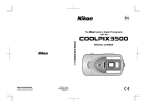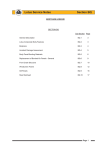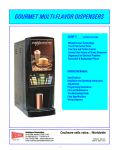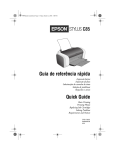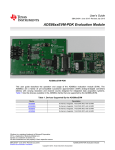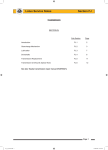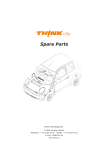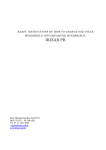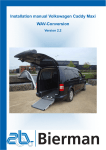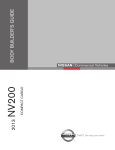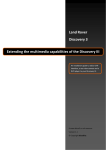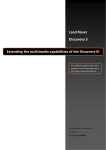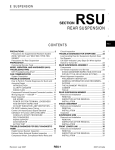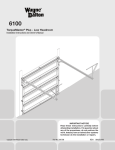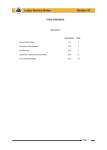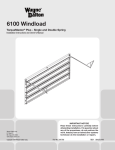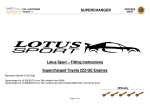Download BODY FITTINGS - Beddysblog.com
Transcript
Lotus Service Notes Section BR BODY FITTINGS SECTION BR Sub-Section Page Removable Roof BR.1 2 Rear Window Shroud (Elise only) BR.2 6 Front Body Access Panels BR.3 7 Engine Cover Lid BR.4 7 Door Hinge Cover Panel BR.5 9 Front Clamshell BR.6 9 Rear Clamshell BR.7 11 Door Mirrors BR.8 13 Door Beam & Hinge BR.9 14 Door Shell Assembly BR.10 16 Door Glass, Guide Rails & Winder Mechanism BR.11 17 Electric Windows BR.12 21 Door Seals BR.13 23 Door Latch Mechanism (without CDL) BR.14 24 Central Door Locking BR.15 27 Instrument Binnacle & Dash Panel BR.16 28 Windscreen BR.17 33 Page 1 Lotus Service Notes Section BR BR.1 - REMOVABLE ROOF The Lotus Elise has been designed to exploit the pleasures of open top motoring, the better to enjoy exposure to the natural environment, unencumbered by the restrictions and confinement bestowed by a cockpit roof. In order to provide some weather protection to the occupants and vehicle interior, and allow the continued enjoyment of the car in unfavourable weather conditions, a simple hard or soft top roof may be fitted. Due to the constantly changing dynamic and wind pressure loadings to which the roof structure is subject when driving, and the tolerances required to allow for repeated removal and refitting of the roof, complete weather sealing of the roof cannot be guaranteed, such that some wind noise and minor water leaks are considered normal for this model. The Elise or Exige should not be subjected to an automatic car wash. Such machines can induce water leaks caused by high pressure water jets which are not representative of conditions encountered during normal use. The brushes used may also damage the fabric of the soft top roof. Exige Hardtop Roof: The Lotus Exige has been conceived and configured as a sports coupé with a removable roof. The aerodynamic performance of the bodyshell including the front spoiler, rear aerofoil, roof panel and tailgate have been tuned to provide the optimum handling balance with the roof panel also contributing to the flow of cooling air into the top of the engine bay. The roof panel may be removed for better access to the interior for servicing, and the car may be driven without the roof fitted, but wind buffeting and increased noise levels will be experienced. In order to avoid discomfort, and so as not to compromise engine cooling efficiency, it is recommended to restrict usage in this configuration to lower vehicle speeds. Soft Top Roof A hollow composite roof siderail is used on each side of the car to bridge each top corner of the windscreen frame to the roll over bar, and provide a mounting for a weatherstip seal, against which the top edge of the door glass abuts. The soft top roof canopy is fixed to each siderail, which uses a spigot pin at the front and rear to engage with a slot in a latch plate on the header rail and roll over bar. A second, spring loaded spigot pin at each end of the siderails, is arranged to slide into a ramped hole on the latch plates and secure and tension the soft top via steel cables running through the front and rear of the roof canopy. Soft Top - Fitting WARNING: The soft top roof should be fitted only whilst the vehicle is safely parked. 1. 2. 3. From its stowage bag in the rear luggage compartment, withdraw the roof assembly and support stays. Lower both door windows, or open both doors. Insert the two, identical, roof support stays, with the arrows pointing forwards, into the slots above the rear window, and in the windscreen header rail. Note that the slots are keyed to prevent the stays being fitted the wrong way round. Lay the soft top roof across the centre of the roof space with the arrows on the side rails pointing forwards. Page 2 FITTING ROOF STAYS Arrows point forward Rear end keyway b332 Lotus Service Notes 4. 5. 6. Section BR Roll out the left hand side of the roof, and engage the fixed spigot pin on the front and rear end of the rail, into the uppermost slot in the latch blocks at the front and rear of the roof aperture. Ensure that the tensioning cables at the front and rear edges of the roof canopy are correctly located in the channels between the seal and body before rotating the left hand side rail downwards. Ensure that both spring loaded pins ‘click’ into their ramped slots indicating that latching is complete. If necessary, ease the latch handles on the inside face of the side rails inwards to facilitate latching. Pull up on the side rail to check security. Spigot pin Spring loaded pin FITTING SIDERAIL ohs111 On the right hand side of the car, repeat steps (4) and (5) for the second side rail, noting that greater rotating force will be required as tension is applied to the canopy. Note: Engaging the left hand roof side rail first, will minimise the possibility of the canopy tensioning cable adjusters causing damage to the roof seals. Soft Top - Removal WARNING: The soft top roof should be removed only whilst the vehicle is safely parked. 1. Open both doors or lower both door windows. 2. On the inside face of the right hand roof side rail, locate the two latch release levers: Pull the two lever handles towards each other to release the side rail latches (press down on the side rail if necessary to relieve the load on the latch pins), and rotate the rail upwards to release the canopy tension. 3. Repeat step (2) for the left hand side rail. Note: Releasing the right hand roof side rail first, will minimise the possibility of the canopy tensioning cable adjusters causing damage to the roof seals. RELEASING ROOF SIDE RAIL ohs112 4. Carefully roll up each side of the roof canopy towards the centre, lift off the car, and stow in the roof bag. 5. Unhook the two roof stays and stow in the roof bag. Important Note: If the roof is not fully dry, it should be stowed for no longer than a few days before unrolling or refitting and allowing to air dry completely. Prolonged stowage of a wet or damp roof will promote rotting of the fabric. Roof Cable - Front: The tension of the steel cable running through the front edge of the roof canopy should be adjusted with the side rails latched. Hook a spring balance under the centre of the cable, and apply an upwards force of 6 kgf. Adjust the cable tension to achieve a vertical gap of 6mm between the cable and top surface of the windscreen surround. Page 3 Lotus Service Notes Section BR Roof Cable - Rear: The roof rear cable tension should be sufficient only to maintain stability of the roof canopy shape. Side Rail Front Latch Plates: The latch plates on the windscreen header rail are secured using a two part adhesive. If necessary, use Betaclean 3900 (A100B6008V), Betaprime 5404 (A082B6337V), and a 50/50 mix of two part adhesive Betamate 7064S (A116B0159V) and Betamate 7014 (A116B0158V) to refix. Hard Top Roof (Parts List 12.04) Note The hard top roof has been designed to provide a seasonal, rather than single trip option. Some owners may prefer to entrust the fitting and removal of the hard top roof to their dealer. When stowing the roof off the car, care should be taken to avoid damage to the roof corners; e.g. use a suitable soft floor covering on which to stand the roof. Fitment or removal of the hardtop is made considerably easier with the assistance of a second person. Use only the ‘Torx’ tool supplied in the vehicle tool kit to tighten or release the roof fixing screws. The hardtop roof fixings are made captive to the roof to prevent their loss. Hard Top - Fitting WARNING: The hard top roof should be fitted only whilst the vehicle is safely parked. 1. Open both doors, and preferably with the aid of an assistant, lower the roof onto the car holding aside the loose tethered fixings to avoid their entrapment or their causing paint damage. Position the rear edge of the roof first before locating the front edge against the windscreen header rail. 2. Locate a front spigot bracket into its latch plate lower slot (lifting the roof slightly to allow this) and retain to the roof with the Torx bolt. Use only the special tool supplied, and do not fully tighten at this stage. FRONT SPIGOT BRACKET 3. Repeat step (2) for the opposite front spigot bracket. 4. Engage a rear cup bracket with the lower tongue on its rear latch plate, and retain to the roof with the Torx bolt. Use only the special tool supplied, and do not fully tighten at this stage. Ensure that the cup is fully located onto the tongue. 5. Repeat step (4) for the opposite rear cup bracket. FITTING REAR CUP BRACKET 6. Push the roof fully forwards before tightening the front spigot brackets using only the special tool supplied. Hold each rear cup bracket in alignment whilst tightening the single fixing screw for each bracket. Do not overtighten. 7. Fit the cover panels to each rear corner of the roof, noting that the panels are handed for left and right sides. Press the panels firmly into position fully to engage the 'Velcro' fixing patches. Page 4 REAR CORNER COVER PANEL b330 Lotus Service Notes Section BR 8. Using the special tool provided, install the windscreen header cover panel by locating first with the central screw, and then by the outer screws before tightening in the same order. 9. Check that the roof is secure by pulling upwards on each corner in turn. If any upward movement is evident, check the correct fitment of all mounting brackets. WINDSCREEN HEADER TRIM Hard Top - Removal WARNING: The hard top roof should be removed only whilst the vehicle is safely parked. 1. WINDSCREEN HEADER TRIM b331 Open both doors. 2. Using the special tool supplied, release the three Torx screws securing the windscreen header trim panel, and remove the panel. 3. Using the special tool supplied, slacken the Torx screw securing each front corner spigot bracket to the roof, but do not yet remove the screws. FRONT CORNER SPIGOT BRACKET b330 4. Pull off the trim cover from each rear corner of the roof panel and remove the screw securing the hook bracket to the latch plate at each rear corner. REAR CUP BRACKET 5. Remove the two front corner bracket fixing screws and lift the front edge of the roof slightly to release the front brackets from their latch plate slots. 6. With the aid of an assistant, lift the roof from the car taking care to restrain the tethered brackets to avoid damaging the paintwork. 7. If storing the roof vertically, take care to avoid damaging the panel corners by using a protective floor covering. Page 5 Lotus Service Notes Section BR BR.2 - REAR WINDOW SHROUD (Elise only) (Parts List 10.20) The rear window shroud is a body colour composite panel which covers the seat belt mounting frame/roof hoop, and forms a capping for the rear of the cockpit. The panel is secured by two brackets on its front edge which are fixed each side by a single M6 screw to the top of the rear bulkhead panel and which are accessible from within the cabin. On some cars it may be necessary first to remove a trim panel secured by five screws. Note that Neoprene washers are used between the brackets and the bulhead. Each rear leg of the shroud is fitted with a captive M6 stud, which locates through a hole in the clamshell buttress, with the retaining nut accessible either from the engine bay, or wheelarch area. A foam gasket is used to prevent chafing damage between the shroud and clamshell. When removing the shroud, it is also necessary to peel off the rear weatherstrip from the front edge of the panel, and to remove the two cant rail latch plates from their brackets on the roof hoop. Note that on the Exige, the rear window shroud is an integral part of the rear clamshell moulding. Roof/'B' post weatherstip seal Neoprene washers Fixing screw to rear bulkhead Fixing nut to rear clamshell Rear window shroud Foam gasket pl1020mt Page 6 Lotus Service Notes Section BR BR.3 - FRONT BODY ACCESS PANELS (Parts List 10.09a) Elise Two removeable, body colour composite panels are provided in the front body to allow access to the front fusebox and brake fluid reservoir. To remove an access panel: Use the hexagonal key supplied in the vehicle tool kit (in the battery cover rear pocket), to release the single threaded fastener securing the outboard corner of the panel, and withdraw the panel REMOVING ACCESS PANEL from the two locating holes in the front body spine. Guard against the lightweight panel being blown away and damaged by a strong wind. To refit a panel: Hook the extended lip on the front edge of the panel beneath the rear edge of the louvre panel before engaging the two locating pegs on the inboard side of the access panel with the grommeted holes in the front body spine. Fit the single screw at the outboard corner of the panel into the captive nut in the body, taking care not to cross-thread or overtighten the screw. Re-stow the hexagonal key in the tool kit. Note that the outboard fastener uses a mounting plinth adjustable in height to allow optimum panel alignment to be achieved. ohs93 WARNING: Ensure the access panels are refitted and properly secured before driving. Exige The access panels on the Exige model are shorter front to back than those of the Elise, and are retained by three socket head screws, the outermost of which features an adjustable plinth to allow panel height adjustment. BR.4 - ENGINE COVER LID (Parts List 10.11) Elise The engine cover/boot lid is moulded from glass fibre composite and incorporates 4 engine cooling outlet grilles secured by double sided tape and plastic rivets into recessed apertures. Two hinges are used to attach the lid to the rear bulkhead, with stud plates fixing the hinges to the bulkhead from the engine bay side, and the nuts accessible from the cabin after removal of the rear bulkhead trim panel. A single, key operated latch mechanism secures the lid to a striker pin mounted on the clamshell engine/boot bulkhead. The latch is released by inserting the ignition key into the lock and turning clockwise, the lock barrel being connected to the latch mechanism by a short link rod. When the latch is released, a spring plunger will lift the lid sufficiently to allow it to be raised fully by hand. Support the lid by inserting the prop provided on the boot bulkhead into the slotted plate adjacent to the latch mechanism. The spring plunger also operates a micro-switch for the alarm system, and is protected from exhaust manifold heat by a steel shield. When closing the lid, fully engage the latch mechanism by pressing down on the cover only immediately above the latch. Note that the lock mechanism plastic cover plate on the underside of the engine lid, serves also to channel any water ingress from around the lock into the engine bay. Drain holes are provided in the gutter surrounding the engine bay, with a collector and drain tube fitted at the rearmost extremity. On USA models, an fluorescent emergency internal release handle is fitted on the underside of the lid to facilitate the escape of a trapped child. To remove the engine cover, release the cover from the two identical hinges. Note that the hinges also serve to clamp the clamshell front edge to the cabin rear bulkhead. Beware that the engine cover is locked whenever it is closed, and always requires the use of the ignition key to release. Owners should be made aware of the importance of having a spare key available in case of inadvertently locking the keys in the boot. Page 7 Lotus Service Notes Section BR Theaded insert in engine lid Engine lid hinge Studplate clamping hinge & clamshell to bulkhead b318 Nut inside cabin Exige On Exige models, the double skin, moulded composite tailgate panel, mates with an air intake duct in the clamshell and roof panel to admit cooling air into the engine bay, and also features seven steel mesh grilles to allow for the exhaustion of hot air. The tailgate panel uses extruded alloy hinges at its front edge, anchored to the underside of the clamshell, and is provided with a gas spring strut to support the lid in the fully open position. The latch mechanism is mounted on the boot bulkhead, where it, and an adjacent alarm plunger switch are protected by a steel heat shield. The latch is operated by a cable release from a lever handle mounted outboard of the driver's seat back. A rear aerofoil with integrally moulded support struts, is secured to the rear end of the tailgate and transfers loads via adjustable abutments into the boot bulkhead and body structure. Tailgate release handle ohs141 Page 8 Lotus Service Notes Section BR BR.5 - DOOR HINGE COVER PANEL (Parts List 10.01) A separate glass fibre composite body panel is used to fill the area beween the door and wheelarch, and uses threaded fasteners to attach to the rear of the clamshell, top of the sill and bottom inboard edge of the sill panel. To remove a door hinge cover panel: From beneath the sill, remove the two fixings securing the bottom edge of the hinge panel to the sill. Remove the filler panel concealing the fixing securing the hinge cover to the door sill recess, and remove the fixing. Remove the wheelarch liner and remove the single screw securing the door hinge cover panel to the clamshell. Release the repeater lamp harness and withdraw the panel. No fixing used in this position Remove front top fixing Door sill filler panel Door hinge cover panel Hinge cover to door sill fixing Hinge cover to sill underside b231 BR.6 - FRONT CLAMSHELL (Parts List: Elise 10.01; Exige 10.01x) The front clamshell is a bonded assembly of several glass fibre composite mouldings incorporating both front wings, the front access aperture, radiator air intake and headlamp housings. The clamshell is secured to the windscreen frame, radiator mounting panel and other panels using threaded fasteners for ease of removal and to facilitate service access and body repair. To Remove Front Clamshell 1. Remove both front body access panels. 2. Remove both front wheelarch liners; Page 9 Lotus Service Notes Fixing inside headlamp housing Section BR Clamshell spine to wiper motor bracket Clamshell lower front edge to undertray Fixing to windscreen frame Fixing to base of windscreen pillar Fixing to radiator mounting panel (not used with oil coolers) Fixing of door hinge cover panel to clamshell b316 3. From inside each wheelarch, remove the single screw securing the top edge of the door hinge cover panel to the clamshell. On cars fitted with front mounted oil coolers, release the hoses from any clamshell clips around the top of the wheelarch. 4. Via each door aperture, remove the single fixing securing a bracket at the top rear corner of the clamshell to the base of the windscreen pillar. 5. Remove the fixing at each side securing the clamshell to the bottom of the windscreen frame. 6. Elise: Remove the two nuts securing the clamshell spine bracket to the wiper motor bracket extension. Exige: Remove the two nuts and bolts securing the clamshell spine to the wiper motor extension bracket, and the two screws each side securing the clamshell channel to the radiator air deflector panel. 7. If fitted, remove the single fixing at the bottom front of each wheelarch, securing the clamshell to the radiator panel extension (not used on oil cooler cars). 8. Remove the headlamp cover/mask assembly from each side by releasing the three socket head screws inside the wheelarch. Remove the clamshell fixing at the front of each headlamp housing. Release the headlamp harnesses, and feed through the clamshell hole. Disconnect the aerial lead(s). 9. Beneath the nose, release the screws fixing the front lower edge of the clamshell to the alloy undertray. 10. Lift the clamshell from the car. Note any spacing washers or shims fitted at any fixing point. Page 10 Lotus Service Notes Section BR BR.7 - REAR CLAMSHELL (Parts List: Elise 10.01; Exige 10.01x) The rear clamshell is a one piece composite moulding incorporating both rear wings, the engine bay aperture, rear transom and integral luggage bay. The clamshell is secured to the chassis and other body panels by threaded fasteners for ease of service access and body repair. To Remove Rear Clamshell 1. Remove the soft or hard top roof (including Exige) - see sub-section BR.1 2. Remove both rear wheelarch liners; 3. Elise: Remove the rear window shroud - see sub-section BR.2. Exige: From within the cabin, remove the two screws above the rear window securing the top edge of the clamshell to the rear bulkhead. Remove the two cant rail latch plates from their brackets on the roof hoop. Peel off the weatherstrip seal from the clamshell flange. Boot floor to subframe Engine lid hinge fixings b317a Fixings to sill panel and grille 'B' post fixing from inside cabin 4. From inside the cabin, remove both seats and the full width trim panel from the rear bulkhead. From the access thus provided, remove the fixing securing the front end of the clamshell to the 'B' post above the engine bay air intake. 5. Elise: From inside the cabin, release the fixings securing the engine lid hinges to the rear bulkhead, and withdraw the engine lid complete with hinges. Page 11 Lotus Service Notes Section BR 6. Release the six (USA market) or eight (other cars) screws securing the fuel filler neck to the clamshell. Withdraw the filler neck from the clamshell aperture, noting the earth braid secured to the roof hoop backstay. Keep the filler cap fitted to minimise vapour hazard. 7. Remove the air filter box intake scroll, and from inside each rear wheelarch, release the air intake grille fixings, and the two screws securing the clamshell to the waistline joint of the sill panel. Withdraw each grille from its retaining clip. 8. Remove the battery and feed the battery cables through the clamshell grommet. Disconnect the rear harness and rear lid switch harness from the area behind the battery, and feed through the clamshell grommet. 9. Remove the rear diffuser panel. 10. From inside the luggage area, release the two screws each side securing the boot floor to the subframe. 11. Unhook the washer bottle. 12. Withdraw the clamshell from the car, noting any spacer pads fitted on the subframe. 13. Refit in reverse order to disassembly with the following notes: Shimming of clamshell floor mounting points: It is most important to maintain a gap of at least 7mm between the phenolic resin heatshield rivetted to the underside of the clamshell boot floor, and the exhaust muffler corrugated heat shield bolted to the subframe. The corrugated shield must touch neither the muffler, nor the clamshell mounted shield, or heat damage may be caused to the clamshell. On factory build, the subframe is marked adjacent to each of the four clamshell mounting points with the shim thickness required. Shim plates are available in 1mm and 2mm thicknesses. If a new subframe is being fitted, or the markings are not visible; Use a straight edge across the clamshell rear mounting points on the subframe, and measure down to the muffler heatshield. Sufficient shims need to be used to bring this dimension to a minimum of 7mm. With these shimplates fitted, trial fit the clamshell and if necessary add further shims to optimise the fit of the clamshell with respect to sill and door shutlines. Measure the shim gap at the boot floor front fixing point. Remove the clamshell, fit the required shim plates onto the subframe and refit the clamshell. Page 12 Lotus Service Notes BR.8 - DOOR MIRRORS (Parts List 12.09) Section BR Mirror housing b240 The manually adjustable, plastic housed door mirrrors, are mounted via an injection moulded plinth to the door shell. A spring loaded ball and socket arrangement provides a means of mirror adjustment, and a sprung attachment of the mirror housing to the pivot socket allows for the mirror to move forwards or backwards on accidental contact, in order to reduce the potential for personal injury or vehicle damage. Replacement of mirror glass The mirror glass is contained in a plastic surround which is clipped into the housing in order to provide for convenient and inexpensive replacement. To remove a glass, pull back the boot between mirror and plinth, and carefully prise the inboard edge of the mirror surround from its retaining clips. Working around the mirror periphery, continue to prise the surround from the housing taking care not to damage the paint on the housing. Press the new glass/surround into the housing until all the retaining clips are engaged, and reposition the convoluted boot. Note that convex glass is normally fitted to both sides, but certain markets, including the USA, use flat glass in the driver's side, and passenger side USA mirrors are convex and etched 'Objects in mirror are closer than they appear'. Mirror glass & surround Mirror mounting plinth Mirror assembly b241a Mirror fixing screw Replacement of mirror assembly The mirror assembly locates in the plastic injection moulded plinth via two spigots, and is retained by a single screw tapping into the lower spigot. To remove a mirror assembly, use a cross head cranked screwdriver, or similar tool, to remove the screw recessed into the inside face of the mirror plinth. Replacement of mirror plinth The mirror plinth incorporates tapping plates to accommodate a single screw into the top leg, and a pair of M5 screws into the bottom leg. The plinth is secured to the door outer panel with access holes for the three screws provided in the inner panel, cosmetically concealed by adhesive patches. Note that a magnet may be required when removing or refitting the rearmost screw. b242b Socket head screw Adhesive patch Page 13 Lotus Service Notes Section BR BR.9 - DOOR BEAM & HINGE (Parts List 10.15) The door shell is bolted to a hollow section extruded aluminium alloy door beam, hinged at the front end to the ’A’ post, and carrying the door latch mechanism, via steel brackets, at its rear end. The front end of the door beam is welded to a second extrusion which forms the rotor of the door hinge. The hinge stator (or hinge bracket) is bolted to an outrigger on the chassis, and incorporates two cylindrical bearing housings fitted with maintenance free pivot bushes. Door hinge adjustments In order to provide for adjustment of door shutlines, the door hinge may be adjusted in two ways: i) Height of the hinge, its fore/aft position, and the pivot axis angle (to control the front/rear height alignment) may be adjusted after slackening the hinge bracket fixing bolts. The tapping plates for these bolts are linked in vertical pairs and are captive, but loose, within the chassis outrigger, and allow for some vertical movement. Horizontally slotted fixing holes in the hinge bracket allow for fore/aft movement. ii) Slotted shim plates fitted between the hinge bracket and chassis, allow the in/out door front edge alignment to be adjusted in steps of 1 rnm, and by varying the shim pack at the top and bottom pairs of fixings, the vertical alignment, as viewed from the front, may be adjusted. Ensure that the clamping load of the hinge bracket to the chassis is not corrupted by the shim plates bearing against the body. If the surrounding body stands proud of the chassis door hinge outrigger, use a suitably cut down shim plate to act as a spacer between the chassis and the adjustment shim pack or hinge bracket. Page 14 Lotus Service Notes Door shell to beam fixing Section BR Tapping plate Shim plate Chassis outrigger Dirt shield Door beam (hinge rotor) Plastic shoe Door restraint spring plate Hinge bracket (stator) b243b Door beam pivot bearings The door beam hinge uses two maintenance free ’top hat’ section synthetic bearings, pressed into the hinge stator bracket. Inside each bearing, is fitted a ‘top hat’ section steel rotor bush, clamped to the door beam extension by an M10 cap head screw threaded into the door beam. The door beam extension also incorporates a cheek flange which abuts against a rubber strip on the hinge bracket to limit door opening angle. A spring steel plate fixed to the front of the hinge bracket is designed to engage around the profiled edge of the door beam abutment flange when the door is fully open, in order to provide a sprung restraint for the door in this position. A plastic shoe is used over the sliding surface of the spring plate to provide for maintenance free operation, with the shoe moulding clamped between the spring plate and chassis. To help protect the hinge mechanism from water and dirt ingress, a plastic shield is push fitted over the retaining nuts for the spring plate. To remove the door assembly, or for access to the door pivot components, the two M10 cap head rotor bush retaining screws should be removed, and the door assembly withdrawn from the hinge bracket. The rotor bushes and/or bearings may then be withdrawn from the hinge bracket. On re-assembly, note that the bearings and bushes are assembled dry from above and below the upper and lower housings respectively, and the cap head screws tightened to 45 Nm. Insert the rubber bungs into the bush ends to inhibit dirt ingress and corrosion. Page 15 Lotus Service Notes Section BR Rubber bung Rotor bush Plastic bearing Door beam/ hinge rotor Stator bracket Cap head screw Hinge bracket fixings b244 BR.10 - DOOR SHELL ASSEMBLY (Parts List 10.15) The door shell is mounted on the door beam via three screws through a flange at the front end of the beam, and by the door latch mounting bracket at the rear end. In order to provide fixing points for the beam, lock mechanism and other components, the door shell includes various tapping plates and brackets jig bonded to the inside of the shell, including fixing brackets for the accurate location of the window guide rails. If a door is to be removed from the car, the preferred method is to release the M10 cap head screws clamping the upper and lower bushes to the door beam. The beam and door shell assembly may then be withdrawn from the hinge stator bracket without losing adjustment of the hinge alignment and door shutlines. If the door shell has to be removed from the beam for repairs or replacement, the beam may be left ’in situ’ and the door shell slid off the beam using the following procedure: Removal of door shell from beam The door shell is secured to the beam via three screws through a flange at the front end of the beam, tapping into nut plates bonded into the door shell, and via two bolts at the rear end of the door to the door beam extension bracket. Access to the two bolts securing the extension bracket to the door beam requires that the door glass first be released: 1. Remove the window winder handle and door trim panel (manual windows) or the door trim panel and window switch (electric windows). 2. Release the three screws securing the interior release handle, and unclip the control rod from the mechanism. 3. Remove the two M6 and the single M8 screw securing the door beam flange to the front of the door shell 4. Release the three M6 nuts securing the door glass to the lift channel, and separate the glass from the channel. Tilt the glass as necessary to allow access to the two M8 bolts fixing the rear end of the door beam to the extension bracket. Remove the bolts and withdraw the door assembly from the beam. Note that it is necessary to remove the drop glass waist seal before the glass may be withdrawn from the door. Page 16 Lotus Service Notes Beam to extension bracket fixing Door beam extension bracket Section BR Captive fixing Door beam flange Door beam Door shell to extension bracket fixing Door shell to beam fixing b245a When refitting the door, take care not to scratch the glass if this is contained in the door. Insert the two rear bolts securing the beam to the latch bracket, but do not tighten until the three fixings securing the front of the shell to the beam flange have been fitted and tightened. BR.11 - DOOR GLASS, GUIDE RAILS & WINDER MECHANISM - Manual Windows (Parts List 11.02) A manually operated door window scissor type lift mechanism is used in conjunction with two steel guide rails and a ’frameless’ door design. The operating principle of the window lift mechanism is that of a scissor linkage, with the front lower end of the primary leg anchored to the door shell, the lower end of the secondary leg sliding in a horizontal channel on the door shell, and the upper ends of both legs sliding in a channel fixed to the bottom edge of the window. The geometry of the system provides for a parallel lift of the glass, where the angle of the bottom edge does not change throughout the range of travel. An extension to the primary scissor leg carries a toothed sector which is engaged by a pinion on the window winder. The front and rear edges of the glass are guided by steel rails which engage with point contact Nylon guide blocks bonded to the glass. The bottom ends of the rails are adjustable in/out to set the inward tilt of the glass, with the 'up' glass position controlled by an eccentric stop on the winder mechanism. Door glass adjustment To adjust the door glass for optimum weather sealing and ease of operation: 1. Fit the soft top roof and fully raise the window. Check the alignment of the top edge of the glass against the seal, and the seal compression along the cant rail and up the 'A' and 'B' posts. A light compression is required; just sufficient to ensure sealing, without imposing loads on the winder mechanism. 2. To adjust the inward tilt of the glass, screw the adjusters at the bottom of each guide rail in or out as necessary. Access is available without removing the door trim panel. Check that the window glass moves freely throughout the range of travel. Page 17 Lotus Service Notes Section BR Door glass lift channel Nylon guide block Door glass tilt Guide rail top fixing Scissor linkage Door glass Adjuster screw Handle pinion Reaction channel Threaded block fixed to rail Steel guide rail Toothed sector Door anchorage point b285a Threaded block fixed to door shell Page 18 Lotus Service Notes 3. Section BR To adjust the alignment of the top edge of the glass, it is necessary to adjust the height of the reaction channel. Remove the window winder handle and door trim panel, slacken the reaction channel fixings, and move the channel up or down as required. Raising the channel will raise the rear edge of the glass. Mesh friction washer Winder spindle Eccentric stop Toothed sector b274 4. To adjust the fully up position of the glass, the eccentric stop on the toothed sector of the winder mechanism must be rotated as necessary. A mesh friction washer is fitted between the eccentric and the sector to help retain adjustment. To replace the door window glass 1. Remove the window winder handle, and the door trim panel. 2. Release the three fixings securing the slider channel to the bottom of the glass. 3. Do not attempt to withdraw the glass from the door without first removing the door waist seal. Carefully prise the one-piece seal off the door shell inner and outer flanges, and release the push fixing from the seal moulding at the rear end of the door. Withdraw the glass from the door shell. 4. Note that new door glasses are supplied complete with jig bonded Nylon sliders and stud plate. 5. Fit the new glass into the door and re-assemble in reverse order to the above. 6. Adjust the glass position as detailed above. To replace door winder mechanism 1. Remove the window winder handle, and the door trim panel. 2. Release the interior release control rod from the door handle and unclip from the latch mechanism. 3. Secure the door glass in the fully raised position, and release the three fixings securing the winder mechanism to the door; two fixings adjacent to the winder spindle; on fixing through the static pivot of the primary scissor arm 4. Manoeuvre the mechanism to free the winder spindle from the door, and to disengage the two upper sliding bosses of the scissor arms from the window channel, and the lower sliding boss from the static reaction channel. Withdraw the mechanism from the door. 5. Before fitting a lift mechanism, lubricate the three slider bosses and the sector teeth with Century Luplex M2 grease (or similar). Fit the mechasnism into the door and engage the three slider bosses in their lift and reaction channels before securing with the three fixing screws. Note that a single M6 spacer washer is used between the pivot of the primary scissor arm and the door shell. Page 19 Lotus Service Notes Section BR Door glass slider block Winder mechanism Lift channel Door glass stud plate b321 Reaction channel 6. Scissor arm pivot fixing Winder mechanism fixing Adjust the glass upstop postion, top edge alignment and inward tilt as detailed above. Door glass guide rails Two guide rails are used for door glass; one for the front and one for the rear edge. Each of the steel, black zinc plated, guide rails, is secured by a single screw at the top end to a jig bonded bracket in the door shell, and by a threaded adjuster at the lower end, engaging in a threaded block fixed to the door shell. Screwing the adjusters in or out will set the inward tilt of the glass and the contact between glass and door weatherseal. To remove a guide rail, first remove the door glass (see above), before releasing the single screw at the top, and releasing the threaded block from the door shell. Page 20 Lotus Service Notes Section BR BR.12 - ELECTRIC WINDOWS (Parts List 11.02) On cars so equipped, switches for the electric windows are mounted in the front of the door trim panels, and are operative only with the ignition switched on. To help locate the switches in the dark, an illuminated dot is provided in the ‘down’ button which glows amber when the lights are switched on. To lower a window, switch on the ignition and press the lower, dished end of the switch in the relevent door. Release the switch to stop window movement. To raise a window, press the upper, domed end of the switch. The electric operation of the door windows comprises; An electric motor and winder drum assembly mounted on a bracket which is bolted to the door shell. A guide channel for the window lift block, incorporating top and bottom cable pulleys, bolted to the door shell. A single drive cable running from the window lift block, around a guide channel pulley, through a flexible conduit, around the motor driven winder drum, through another conduit, around the second guide channel pulley and back to the window lift block. An adaptor plate bolted to the stud plate on the lower edge of the door glass. Viewed from outboard Upper guide pulley Window upstop Window lift block Drive cable Motor mounting plate Adaptor plate fitted to glass Guide channel Window winder drum Bottom guide pulley Window lift motor b337 Door Glass Adjustment The door glass guide channels and adjustment procedures are the same as used on manually operated windows. Refer to sub-section BR.11. The upstop for the door glass is fitted at the top end of the lift block guide channel in the form of an adjustable stop screw against which a projection on the window lift bracket abuts. The front/rear height of the top edge of the glass may be adjusted at the slot where the front of the window lift bracket attaches to the door glass. Page 21 Lotus Service Notes Section BR Replacement of Window Lift Mechanism The window lift mechanism comprises the motor, drive cable and guide channel assembly as a complete unit. To remove the mechanism: 1. If possible, raise the window fully for optimum access. 2. Remove the door trim panel and disconnect the window switch. Peel off the plastic water shielding. 3. Release the window lift bracket from the door glass and secure the glass in the fully raised position taking care not to damage the door waist seals in the top of the door shell. Guide rail top fixing Motor mounting bracket fixings b339 Guide rail bracket fixings 4. Unplug the motor electrical connector. Release the three fixings securing the motor mounting bracket, and the two remaining fixings securing the guide channel to the door shell. 5. Carefully manoeuvre the lift mechanism from the door. 6. Refit in reverse order to removal, noting that the motor mounting bracket is fixed directly against the door shell, but that 4mm plastic spacers are used at each of the three guide rail fixings.. Door shell inner panel Setscrew and washer Window lift motor 4mm plastic spacer Threaded insert Cable winder drum Page 22 Motor mounting bracket Guide rail bracket Guide rail b340 Lotus Service Notes Section BR Note that the door glass is common to manually operated windows, with slider blocks bonded to the front and rear edges, and a studplate channel bonded to the lower edge. For electric window operation, an adaptor studplate is used to provide two studs for the window lift bracket. BR.13 - DOOR SEALS (Parts List 11.01) Drop Glass 'Waist' Seal The door drop glass waist seal is a single unit comprising inner and outer seal extrusions joined around the rear end by a moulded capping piece. Each length of seal is pressed onto the top edge of the inner or outer door panel, with a plastic rivet securing the capping piece. The seal should be removed before withdrawing the door glass or guide channels from the door. A 'cheater' seal is bonded to the front and rear faces of the door mirror mounting extension. To fit a new seal: - Clean the bonding surfaces on the door shell edges with Betaclean 3900 (A100B6008V). - Apply Permabond A905 surface conditioner to the bonding surfaces of door shell and cheater seal. - Apply Loctite 382 adhesive to the inside of the cheater seal and fit onto the door. Door Weatherstrip A hollow section rubber weatherstrip is bonded around the door aperture and roof landings to seal against the door shell and roof. Different seal configurations are used for the door and roof areas, with specially moulded sections to interface with the roof cantrails. The seal is divided into front and rear sections, with a joint at the bottom front of each door aperture. The weatherstrips are manufactured with a self adhesive backing strip. Before fitting a new seal, the bonding area on the body must be thoroughly cleaned with Betaclean 3900 (A100B6008V). In the critical area of the 'A' post to windscreen header rail corner, an adhesive promoter 3M 4298UV (A116B6000V) should be applied along the seal path to to ensure optimum seal retention. Trial fit the seal before peeling off the protective backing from the adhesive and applying the seal, ensuring that the moulded sections at the cant rail interfaces are correctly positioned. When fitting the rear section of the seal, remove the backing strip from the seal in the section around the latch plate, and fully insert the weatherstrip nodule into the gap between the 'B' post and rear window shroud. Weatherstip seal Seal path Weatherstrip nodule Rear window shroud 'B' post b335 Page 23 Lotus Service Notes Section BR Continue to remove the backing strip and stick the weatherstrip along the seal path down the 'B' post and along the bottom of the door aperture. Cut the seal to mate with the end of the front weatherstrip. Repeat for the opposite side, and then remove the top section backing strip and secure the seal along the roof shroud flange. Use a roller wheel along the whole length of the seal to ensure full adhesion. A secondary 'J' section seal is applied to the front vertical face of the door shell, linking to the cheater seal. BR.14 - DOOR LATCH MECHANISM - Without CDL (Parts List 10.17) Interior release handle Interior release control rod Relay lever assembly Exterior lock control rod Door latch mechanism Bracket, door beam rear end to door shell Page 24 Exterior release button b251a Lotus Service Notes Section BR The door latch mechanism is fitted inside the rear face of the door, which is reinforced by a steel plate bonded to the glass fibre composite door shell. The latch engages with a striker pin which passes through the composite sill/'B' post moulding, into a captive nut on the roll over bar. An external locking door release button is mounted via a reinforcing plate, in the top rear of the door outer shell, and transmits its motion around the rear edge of the door glass to the latch mechanism via two short link rods and a relay lever. The interior release handle is mounted in the front of the door inner shell, and is connected to the latch mechanism by a control rod. No interior control of door locking is provided. Interior Release Handle Remove the window winder handle and door trim panel. Remove the four screws securing the interior handle assembly and unclip the control rod end clip to allow the rod to be unhooked from the handle. On refitting, ensure that the control rod is located in the guide clips. Trim panel Door shell Release handle Rod guide clips b260a Exterior Release Button Remove the access disc from the rear face of the door, and the rod access grommet lower down. Release the two screws securing the lock assembly and angle bracket to the tapping plate bonded in the door shell. Unclip the link rod from the relay lever, and withdraw the lock button from the door. Exterior release button fixings (use Permabond A130 A912E7033V) Control rod access b255b Page 25 Lotus Service Notes Section BR Latch Mechanism Remove the window winder handle and door trim panel. Unclip the control rod from the interior release handle, and unhook from the latch mechanism. Unclip and disconnect the short link rod between the relay lever and the latch mechanism. Remove the three M6 screws securing the latch mechanism to the door, and withdraw the latch. Viewed through outer door skin Plate bonded inside door shell Control rod to interior handle Control rod to relay lever Rear b261 Outboard Control rod to latch Relay Lever Mechanism The relay lever components comprise a Rod to shaft with an integral lever on one end, which exterior connects to the exterior lock button, and a button second lever pinned to the other end, which connects to the latch mechanism. The shaft is supprted in two fibre bushes housed on the bracket connecting the rear end of the door Plain & spring beam to the door shell. To remove the door washers beam extension bracket complete with relay lever mechanism: Pivot bush Remove the window winder handle and door trim panel. Release the three M6 nuts securing the Relay lever/shaft door glass to the lift channel, and separate the glass from the channel. Do not attempt to b256 withdraw the glass from the door without first removing the door glass waist seals. Remove the access grommet from the rear face of the door, and unclip the exterior lock link rod from the relay lever. Similarly disconnect the link rod between the relay lever and the latch mechanism. Support the door shell before removing the two M8 bolts fixing the rear end of the door beam to the end bracket, and the two screws securing the bracket to the door shell. Remove the bracket complete with relay lever assembly from the door. Refit the bracket in reverse order to removal. Page 26 Lotus Service Notes Section BR BR.15 - CENTRAL DOOR LOCKING (Parts List 10.17) On cars so equipped, the central door locking (CDL) operates on the driver’s and passenger’s doors in conjunction with the Cobra 8185/8186 security alarm system. For full details of the alarm system, see subsection MP.1. To lock the car, remove the ignition key, close both doors and check that the engine cover and front body access panels are secure. Arm the security alarm in the usual way by pressing once, for a full second, the larger of the two buttons on the transmitter key. This action will both arm the alarm and electrically lock the driver’s and passenger’s doors. If it is desired to lock the doors from inside the vehicle, for example to deter highjack attempts, a CDL rocker switch is provided on the front of the gear lever shroud which should be pressed to the right to lock both doors with or without the ignition switched on. Alternatively, the doors can be locked individually by depressing the button at the rear end of each door sill. Note that whichever locking method is used, the doors will be ‘deadlocked’ such that the interior door release handles are inoperative. To unlock the doors, press once, for a full second, the larger button on the transmitter key. The alarm will be disarmed and both doors unlocked. Alternatively, from inside the car, press to the left the rocker switch on the gear lever shroud to unlock both doors, or raise the sill button on each door. Note that in the event of a vehicle collision which causes the safety inertia switch to be tripped, the doors will automatically be unlocked. Notes: - In the event of a flat vehicle battery, the central door locking will not operate. The doors can be unlocked only after opening the boot lid and restoring power to the battery by substitution, re-charging or ‘jumping’ to a second battery. - To lock the car with a flat or disconnected battery, use the mechanical key in each exterior door button to disconnect each release button from the latch. This technique does not 'deadlock' the interior release handles, but does allow continued key access to the car until restoration of battery power. - To deadlock the car with a flat vehicle battery, or without the use of the transmitter or mechanical key, close and lock one door using the sill button, and for the second Door sill button door, hold the exterior release button b338 pressed in and depress the sill button before closing the door. Access is now available only on restoration of electrical power. Door Locking Actuator A CDL actuator is screw fixed to the door shell below the latch mechanism, and uses a link rod which passes through the rearmost (shortest lever length) hole on the latch lever, before continuing upwards to the door sill button. The latch mechanism within the door is protected from tamper attempts by a plastic security shield fixed with screws through the door shut face. To remove an actuator, remove the door trim panel, security shield, release the two actuator fixing screws, unhook the actuator from the link rod and disconnect the harness. Refit in reverse order to removal, noting that no adjustment is required. CDL actuator Rearmost hole Page 27 Lotus Service Notes Section BR BR.16 - INSTRUMENT BINNACLE & DASH PANEL (Parts List 14.10, 14.05, 14.05b) The dash panel comprises interlinking alloy extrusions which join the chassis scuttle beam to the base of the windscreen pillars, and also provide a mounting for the fascia top trip panel. The lowermost extrusion, which incorporates a curved shelf, is keyed into a slot in the scuttle beam and is secured by rivets at each end to the beam. On non-airbag cars, two interlinking extrusions are joined by self tapping screws to form the top part of the dash panel, which is divided into two sections by the steering column. This upper dash is used to house the face level vents and audio set. On airbag cars, the two upper extrusions are combined into a single extrusion, which profile and function is similar to non-airbag cars, and which bridges the steering column area and includes an aperture through which the passenger airbag is deployed. The upper extrusion(s) slots behind the top edge of the lower dash, and is secured at each end by two screws to threaded inserts in the base of the windscreen pillars. Additional location is provided by rivets securing the speaker or door sill trim panel mounting brackets. On non-airbag cars, a skinned foam fascia top panel, trimmed with suede material, joins the top of the dash to the base of the windscreen and incorporates the demist ducting and four windscreen outlet vents, with a moulded plastic capping panel around the front of the fascia top and surrounding the vents. At each end of the fascia, a moulded plastic panel joins the fascia to the door sill finisher, and is used to mount the front speakers and lighting switches. On airbag cars, the untrimmed skinned foam panel incorporates the ducting to the six fixed demist outlet vents, and also houses the front speakers. The face level vent outlets are housed in the moulded plastic panels joining the fascia to the door sill finishers and in a central moulding also housing the audio set. For access to the climate controls, or electrical components mounted on top of the chassis scuttle beam, the fascia top panel must be removed. To Remove Fascia Top Panel - non airbag cars 1. Remove the steering column upper and lower shrouds: - Remove the four screws securing the shroud upper section. - Pull out the grommet from around the ignition switch and remove the three screws securing the lower shroud to the column. - Disconnect the trip reset button from the lower shroud. Column upper shroud Lower shroud mounting bracket Column lower shroud b258a Page 28 Lotus Service Notes 2. Section BR Release the two fixings securing the binnacle mounting brackets to the column, and withdraw the instrument pack and cowl. Unplug the harness connector. Instrument cowl Instrument pack Binnacle mounting bracket Mounting bracket fixing screw b259a 3. Release the screws securing each fascia end (speaker) panel, disconnect the switch and speaker harnesses and withdraw the panels. 4. Carefully prise each windscreen outlet vent from the fascia. 5. Remove the screws at each end securing the fascia capping panel, and withdraw the panel. 6. Remove the plastic finisher above the climate controls. Remove the four screws securing the top flange of the dash extrusion to the underside of the fascia top. 7. Lift the rear of the fascia top to release the two locating bosses from the keyhole slots in the dash, and pull the fascia rearwards to withdraw the two front edge spigot pins. 8. If the demist ducting is found to have become detached, or loose from the facia top foam moulding, the duct should be refixed as follows: - Remove any fixing screws, separate the duct from the fascia and remove any glue from the ducting. - Roughen the bonding surface of the fascia with sand paper and clean and degrease with Betaclean 3900 or Acetone. Similarly clean and degrease the bonding surface of the demist duct. - Prime bonding surfaces with Betaprime 5404 and bond with Betaseal 1701 or similar one component polyurethane adhesive. Page 29 Lotus Service Notes Moulded plastic capping panel Section BR Non-Airbag Type pl1405mt Capping panel fixing Fascia top panel Dash fixing to screen frame Column shroud Fascia to dash fixing Fascia top recess finisher FLV/climate control housing Dash lower extrusion Keyhole slot for fascia Audio set support Dash upper extrusion Fascia top Upper & centre extrusions Chassis scuttle beam Lower extrusion b202a Page 30 Lotus Service Notes Section BR Airbag Type Instrument pack mounting bracket Column shroud support leg Fascia top panel Column shroud Dash fixings to screen frame FLV/audio housing Climate control housing Airbag door Airbag shute Dash upper extrusion Dash lower extrusion Audio set support Rivet to scuttle beam pl1405mtb Page 31 Lotus Service Notes Section BR To Remove Fascia Top Panel - airbag cars WARNING: The airbag Sensor & Diagnositic Module can maintain sufficient voltage to cause an airbag deployment for up to 20 seconds after the battery has been disconnected. Before working on the airbag system, or in close proximity to an airbag, first take the following precautions to disable temporarily the airbag system: a. b. c. d. e. Turn off the ignition. Before disconnecting the battery, use the Lotus Scan tool to read any stored trouble codes. Disconnect the negative (earth) lead from the battery and tape back to ensure that no contact with the battery negative terminal can be made. Wait for 30 seconds. If working on or near the steering wheel, locate the yellow harness connector alongside the steering column near the column upper fixing. Unplug this connector. Note that the connector is fitted with 'shorting bars' which automatically interconnect the high and low terminals of the airbag to prevent accidental deployment caused by a voltage differential. When service work has been completed, reconnect the harness plug and secure with its locking feature, and reconnect the battery. Ensure the airbag tell tale lights for a few seconds with ignition and then goes out. 1. Column shrouds: Remove the two screws retaining the top part of the shroud, and the four screws retaining the lower part, and withdraw both parts from the column. 2. Instrument shroud: Pull the instrument shroud backwards to release the four spring clips from their apertures in the dash panel. 3. Sill top trims: Release the two screws at the bottom of the coin pockets at the front of each sill, and pull the sill top trim panels from the chassis. 4. Dash end panels: Release the two screws within the top of each coin pocket, and withdraw the switch panel (driver's side) and blanking panel (passenger side) from the dash end panel. Unplug the wiring harness from the switch panel. From within the aperture, release the two screws retaining each end panel to the dash, and pull the panel rearwards to withdraw the spring clips in the top of the panel from the dash. 5. Airbag door: Pull the airbag door away from the dash, which action will probably require the four retaining clips to be renewed. Note that the door is constrained by two tether straps. 6. Centre vent panel and radio surround: Release the two screws at each side of the panel and withdraw the panel from its two spring clips. 7. Fascia top panel: Remove the 5 screws securing the rear edge of the panel to the dash rail, and withdraw the panel rearwards to disengage the two spigots from the base of the windscreen surround. Disconnect the speaker cables. 8. Refit in reverse order to removal. Page 32 Lotus Service Notes Section BR BR.17 - WINDSCREEN (Parts List 11.01) The laminated windscreen, together with self coloured synthetic finisher moulded around the top and side edges, is bonded to the composite windscreen mounting frame using Betaseal flexible polyurethane adhesive. It is not practicable to remove a windscreen from a car and then refit the same glass, as removal of the screen will require cutting the surround finisher which is available only as part of a new windscreen assembly. To Replace Windscreen Parts required: Windscreen Betaseal Kit A075B6158F Plinth, interior mirror mounting Plinth Adhesive Kit A116U0194S 1. On non-airbag cars, to minimise the possibility of trim damage, remove the fascia end (speaker) panels, and the fascia top capping panel (around inside base of windscreen). 2. Remove the front clamshell (see sub-section BR.6). 3. Remove the wiper arm from its spindle, and the interior mirror from its plinth. 4. Cut around the whole length of the windscreen surround finisher to allow access to the 'screen adhesive joint. Apply suction handles to the outside surface of the screen. 5. In order to incur the minimum risk of damage to the windscreen composite mounting frame, the preferred method of cutting the windscreen adhesive is by the use of a 'cheese' wire. Protect the visual surface of the windscreen frame with tape before commencing the cutting operation. Screen removal tool Cutting wire b322 Page 33 Lotus Service Notes Section BR 6. After cutting out the screen, remove old adhesive from the windscreen frame sufficiently to leave a consistent and flat surface for the new bond. 7. Clean the whole of the inside surface of the windscreen with a 50% solution of water and isopropanol. Allow to dry. 8. Fit the interior mirror plinth to the inside of the windscreen using the adhesive kit and instructions supplied. Windscreen top edge Screen centreline Obscuration band Mirror position on RHD offset to left 79mm 63mm 63mm Mirror position on LHD offset to right b263 9. Clean the whole of the inside surface of the obscuration band, and the bonding surface on the windscreen frame with the wipe cleaner. 10. Apply a 25 mm wide band of Betaprime around the inside periphery of the glass. Similarly apply to the whole of the bonding surface on the windscreen frame, and to the windscreen bottom laminated edge. Allow to dry for a minimum of 5 minutes. If the screen is not fitted within 48 hours, the primer should be re-applied. 11. Cut the nozzle of the Betaseal cartridge to the dimensions shown to produce a triangular section bead. Holding the cartridge vertically, extrude a bead of adhesive around the screen, using the edge of the finisher as a guide along the top and sides, and following the centreline of the primer band along the lower section. 8 mm 10 mm 60 mm b264 Page 34 Lotus Service Notes 12. Section BR Cut three 4mm spacer blocks from the material supplied in the Betaseal kit, or from rubber or plastic material, and position in the inside edge of the adhesive bead running along the bottom of the class. These spacers are used to control the fitted height of the glass, and the wiper arm clearance. Cartridge nozzle Betaseal bead Edge finisher Obscuration band Primer band Bead along centre of primer band Spacer block in inside edge of bead b265a 13. Using the suction handles, carefully lower the windscreen onto the frame, with the edge finisher firmly butted against the top and sides off the frame recess. Press around the periphery of the screen to compress the adhesive until contact with the finisher spacers and bottom edge spacer blocks is felt. Carefully examine the integrity of the whole length of the joint, if necessary using a spatula to force extra adhesive into any suspect areas. Wipe off any excess adhesive extruded from the joint, or alternatively, allow the adhesive fully to cure and cut away any excess using a scalpel blade. 14. Use duct tape and/or support blocks to hold the screen in position and do not disturn until the Betaseal is fully cured. This will take approximately 4 hours dependent on atmospheric conditions, with a longer period required in dry atmospheres. 15. Refit wiper arm, interior mirror and front clamshell. Page 35 Lotus Service Notes Section BR Spillage of material a) Any spillage of Betaseal onto unprimed glass can be readily peeled off after it has cured. b) Any spillage onto the bldy can be removed with either Wipe Cleaner No.4, or white spirit. Shelf life a) Betaseal primer has a useful life of about 24 hrs. after exposure to the air, after which it starts to become spongy. If the material is spongy, DO NOT USE. Always use glass primer immediately on opening, and replace the lid after use. b) Betaseal has a shelf life of over 6 months at ambient temperature in the original unopened package. Page 36




































